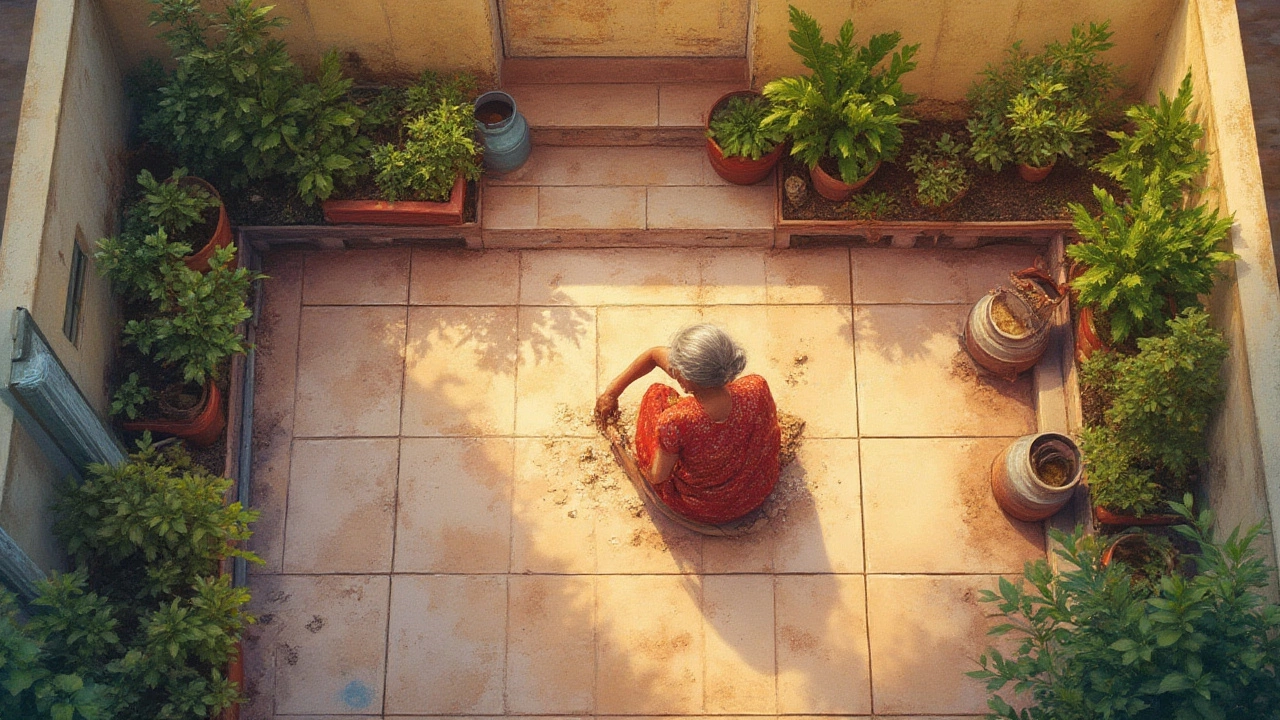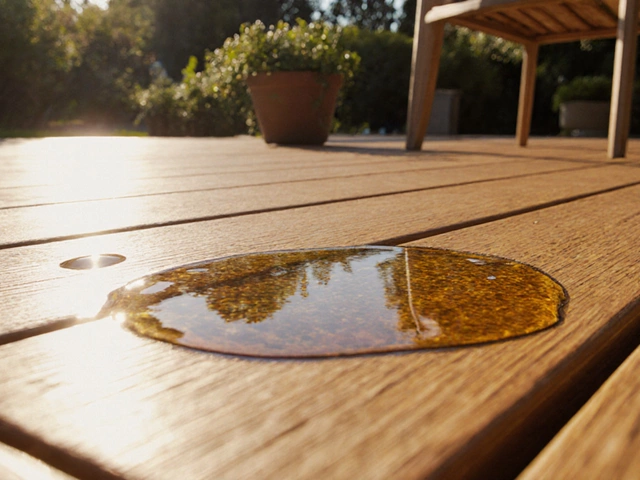If you think all terraces are just forgotten concrete slabs cluttered with plastic chairs, you’re missing out. The prettiest city terraces look effortless, but they survive all kinds of dirty, damaging realities—urban grime, water leaks, wobbly planters, and mold. Still, with the right habits, any terrace can be a long-lasting, inviting escape. Don’t imagine endless chores: smart choices in materials, plants, and simple routines keep maintenance low-key and your slice of sky looking its best all year.
Understanding the Unique Challenges of Terraces
Every terrace faces a different set of headaches depending on its exposure, floor material, and how you use it. But there’s one universal truth: being open to the elements is equal parts blessing and curse. UV rays, extreme heat, pounding rain, bone-chilling wind—every corner gets tested. Wind can dry out planters in a flash, fade fabrics, and loosen lightweight objects. Rain does its own dirty work, too. According to weather.com, terraces in high-rise buildings get hit by 20–50% more wind-driven rain compared to sheltered street level spots.
Add air pollution to the mix and urban terraces become magnets for black dust and greasy film. A 2022 study in Mumbai found that horizontal surfaces accumulated up to 50g of airborne dust per square meter per week in peak pollution seasons—that’s enough to clog drains, coat leaves, and even stain tiles if left for long. And don’t forget invisible threats: water seeping through a cracked surface can turn your cozy rooftop nook into a neighbor’s leaky ceiling. That’s why regular cleaning, drainage checks, and timely waterproofing matter as much as planting pretty flowers or buying chic furniture.
Guess what else? Structural movement isn’t some rare disaster—it’s a normal part of concrete and steel. Terrace surfaces flex and expand with temperature changes, which causes joints and tiles to crack slowly over years. Think of a terrace as a living platform. It will shift, settle, and need repairs. Wise terrace owners jump ahead of issues before they turn into major, wallet-emptying projects later.
Cleaning and Caring for Terrace Surfaces
The most neglected terraces always show the same signs: slippery green patches, streaks where water pools, or that dingy, grimy look you can spot from the street below. Regular cleaning isn’t optional—it’s your terrace’s first shield. For concrete or stone floors, an old-fashioned stiff broom and a bucket of water (with a splash of eco-friendly soap) do wonders. Once a month, scrub dirt out of grout lines and drain covers. That keeps the slippery stuff away and drainage flowing. Avoid anything harsh—steel brushes might scratch tiles; acidic cleaners can stain. If you’ve got fancy wooden decking, aim for a soft bristle brush and a mild wood cleaner so you protect the finish. Regular wood oiling (twice a year) prevents cracks and sun fading.
Terraces are often forgotten when it comes to pressure washing. But using a pressure washer once or twice a year blasts away old stains, algae, and built-up grime. Don’t overdo it—always use the lowest setting, keeping the nozzle a safe distance from delicate tiles. If you’re worried about water use, choose cleaning days after rainy spells; the dirt will lift faster and you’ll save water. Speaking of runoff, terraces should always slope gently toward drains—that means puddles shouldn’t stick around for more than an hour. Stagnant water isn’t just ugly; it breeds mosquitoes. If you spot chronic puddles, you need to check for clogged outlets, poor slopes, or sunken patches. Quick tip: try the coin test. Place a coin at random points—does it always drift toward a drain on a wet day? No? Time to fix the slope.
Urban grime is more than awkward for sunset selfies. The fine dust and soot can stain light tiles, turn white railings gray, and settle on plants. A diluted vinegar mix on a cloth pulls most stains from stone and metal. But lay off any home-cleaning hack that recommends bleach—bleach can eat through grout and damage surrounding plants. Do a surface scan each week for cracks, loose tiles, or soft spots in grout. These little flaws are where leaks start, and they’ll only get worse with seasons of frost and sun. If you spot a loose tile, pull it up, clean the area, and reset using exterior-grade tile adhesive. For hairline cracks in grout, seal with a silicone-based grout sealer made for outdoors. Minor jobs you do now mean you won’t need to strip the whole floor later.

Waterproofing: Your Terrace’s Best Friend
Waterproofing isn’t glamorous, but it’s the only thing standing between your happy terrace and a heartbreaking phone call from the downstairs neighbor. Skip it, and you almost always regret it. Commercial waterproofing membranes—think liquid sealants, plastic sheets, or cement-based coats—are big investments, but they last for a decade or more. According to a report from the Indian Green Building Council, terraces with modern membrane systems required 60% fewer repairs than untreated ones after just five years of monsoon rains.
The weakest points are always where different materials meet: around the drain, at railing bases, and against walls. These grab dirt and water, then flex and crack when temperatures swing. For new terraces, ask for a triple-layer system: primer, membrane, and a protective screed or tile. For existing spaces, look for peeling or bubbling paint, increasing dampness inside below the terrace, or musty smells—that’s water seeping in. Touch up with a brush-on waterproofing solution, especially around all joints and corners. If you see white, chalky efflorescence (that’s mineral salts from water), hit the area with a stiff brush, patch the joint, and reseal.
Moss and algae might look rustic at ground level, but on a terrace they signal water retention. These patches usually mark where water sits too long after rains. Scrub them off gently and investigate for underlying cracks or sunken tiles—fixing these at source is easier (and way cheaper) than re-doing a full terrace floor. Ready for a pro tip? After wild winters or monsoons, pour water slowly over the terrace and watch for spots where it lingers or seeps into cracks. Mark those sites (masking tape works) and return on a dry, sunny day for repairs.
Keep a yearly waterproofing calendar. Tackle big fixes right before your toughest season—late spring for summer monsoons, or late fall before heavy snows. The least glamorous tasks, like cleaning out weep holes or checking expansion joints, save thousands in repairs later. A little planning, some elbow grease, and waterproofing takes stress off both your mind and your neighbor’s ceiling.
Keeping Terrace Plants Happy and Healthy
You can spot a neglected terrace garden from miles away: dried-out containers, spindly sunburned leaves, or planters drowning in waterlogged soil. Terrace plants have a tougher life than those pampered in backyard gardens. They’re always up against more heat, more wind, and less soil—sometimes as little as 20cm in a typical container. Even so, terrace gardens win points for creativity, convenience, and wow-factor. The trick is to pick plants suited for the wild rooftop microclimate, then make watering, feeding, and pruning super easy.
First, choose pots with proper drainage holes. Yes, really. Without drainage, roots suffocate and rot—according to the American Horticultural Society, overwatering kills more terrace plants than drought. Go for thick, durable containers in clay, ceramic, or heavy-duty plastic. Thin or cheap plastic warps and cracks after a couple of summers. If you’re planting directly over your terrace floor, always use a protective waterproof mat or tray underneath to keep leaks out of your ceiling.
Watering is a delicate balance. Summer heat dries pots fast; winter might mean they never quite dry out. In peak summer, watering every morning is nearly a must, while in rainy season or cool months, once or twice a week might suffice. Self-watering planters or a basic drip irrigation kit cuts your labor without risking roots sitting in water. And don’t just rely on rain—most terraces don’t get even watering thanks to wind and walls. Mulch atop the soil (small pebbles, bark chips, or coco husks) locks in moisture and evens out temperatures in containers.
Feeding matters more up high than at ground level. Container soil loses nutrition extra fast with frequent watering. Go for slow-release fertilizer pellets every 3-4 months, or compost tea for a monthly boost. If you want veggies, try leafy greens, tomatoes, or spicy chilies in summer—these handle shallow roots. For color, geraniums, marigolds, and trailing petunias love sun and wind. Shade spots? Ferns and peace lilies are much happier. Adjust your plant choices as the seasons change—swap out thirsty summer annuals for cold-loving ornamentals or bulbs.
Pruning and deadheading keeps everything neat and disease free. Ditto for sweeping up fallen leaves—they attract pests you don’t want in dozens. Be kind to pollinators: add flowering herbs or native plants, and avoid harsh pesticides. Remember, every plant brings a little more insulation and coolness to your terrace. According to the Green Roofs for Healthy Cities organization, vegetated terraces can reduce ambient rooftop temperatures by up to 5°C compared to plain tiles, cutting your AC bill. Here’s a quick cheat sheet for plant care at a glance:
| Plant Type | Watering | Fertilizer | Best Position |
|---|---|---|---|
| Herbs (basil, mint) | Every 2-3 days | Monthly, liquid feed | Partial sun |
| Succulents | Weekly | Rarely | Full sun |
| Marigolds, Petunias | Every 1-2 days | Every 3 months | Full sun |
| Ferns, Peace Lily | Every 3-4 days | Monthly | Shade |

Furniture, Décor, and Seasonal Adjustments
Even the sturdiest outdoor furniture takes a beating on the terrace. Morning dew, blazing sun, dust storms, and even the city’s pigeons seem to team up against your stuff. You want pieces made for true outdoor use: powder-coated steel, teak, or engineered plastics. Skip any fabric that isn’t labeled “outdoor”—otherwise, you’ll replace faded, mildewed pillows every season. Monthly wipe-downs (simply with water and a squirt of mild soap) clear away grime and keep stubborn stains from setting. If cushions get soaked, dry them fast in midday sun to avoid mildew. Store smaller pieces inside over the toughest season. Or, splurge once for custom covers—they do save money in the end.
Decor is where you stamp your personality on your terrace—lanterns, windchimes, small sculptures, or string lights. Urban dust smudges glass and metal, so clean as you would your windows: vinegar spray, microfiber cloth, and a watchful eye for rust at joints. Swap out delicate décor for heavier items before a storm, and use weights or zip-ties for lighter decorations. If you love climbers and vines, keep trellises strong and fixed into walls, not just wedged in a pot—wind can topple unanchored towers overnight.
Every terrace goes through cycles. Spring calls for cleaning and replanting—switch out old soil, wipe surfaces, trim branches, and update container positions as sunlight shifts. Summer demands extra shade, regular plant checks, and maybe mosquito defense (citronella candles or mint work well). In fall, you’ll prune, stash away delicate plants, and inspect waterproofing. Before winter, tuck in pots, trim back perennials, and pile up fallen leaves for compost. This rhythm keeps your space both safe and vibrant. Don’t forget the quick visual check after every storm: loose furniture, new leaks, or fallen plant debris. Cleaning as you go saves regret later.
Maintaining a terrace isn’t about endless effort—it’s about building good habits and choosing materials, plants, and furniture that can handle the rooftop wilds. Crack the code and you’ll have your own little sky-high sanctuary, come rain, dust, or city chaos.




